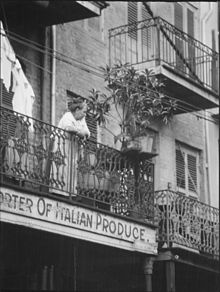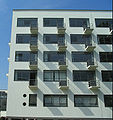balcony
A balcony ( [balˈkõ] also [balˈkɔŋ] , especially southern German / Austrian / Swiss. Also [balˈkoːn] ; plural balconies or balconies , as a collective term balconyage [ˈbalkoːnɑʃɘ] ) is a platform in front of a building facade. The balcony lies above the ground level on consoles or beams that protrude from the structure. A balcony is bordered by a parapet or a railing .
etymology
The word balcony was borrowed from French ( balcon ) into German in the 18th century and ultimately goes back to a Germanic, namely Longobard original word * balko , which corresponds to Old High German balko , " bar " , via the Italian balcone .
Demarcation and designs

Colloquially, the term balcony is often used in general terms for different types of raised, accessible platforms. In architecture and construction, however, a distinction is made between different types of construction:
- A balcony is an elevated, open exit on an upper floor that protrudes from the wall. The cantilever plate can be self-supporting or supported on the wall by means of brackets or struts .
- In contrast to the balcony, the open platform of the arbor or Söller is supported by columns , pillars or walls. Apart from the construction, the function is mostly the same as that of a balcony.
- A raised exit that does not protrude from the wall but remains within the cubature of the building is called a loggia . A loggia of this type mostly fulfills the same function as a balcony, unless it is extended to a continuous portico .
- If an excellent part of the building is roofed and surrounded by its own walls, it is called a bay window . Since balconies can also be roofed and (partially) glazed, the transitions between the two types of construction are sometimes fluid.
- The French balcony is a floor- to- ceiling window with a railing that protrudes only minimally from the facade .
The components listed have the function of the increased outlet as a common feature. A partially, half or completely open area on or below the ground floor level of a house is called a terrace . If this area is covered, one speaks of a veranda .
Arbor in the interior: organ gallery
Representative buildings
The apparition balcony is often found on representative buildings and faces public streets or squares. The name indicates that dignitaries appear on such a platform and can show themselves to an audience gathered in front of the building. Appearance balconies are derived from sacred architecture and were a separate criterion for new buildings until the end of the 19th century and were subject to their own rules. An appearance balcony is usually surrounded by a parapet (a thick, continuous structure for fall protection). In more modern buildings, there is also a simple railing that borders the appearance balcony on two or three sides. One example of this is the Benediction Loggia at St. Peter's Basilica , where a newly elected Pope is presented to the world.
housing
Balconies belong to the outdoor seating . In residential construction , balconies were built as so-called decorative balconies on the building fronts on the street side and as commercial balconies on the rear courtyard facades of the buildings until the end of the 1930s . The commercial balconies were mostly in front of the kitchens and intended for outdoor housework or for drying laundry. The dimensions of the area were measured as follows: minimum depth 1.00 m = 1 chair.
With balcony glazing, the area over the parapet is glazed afterwards . The result is a glass bay window that can serve as a small winter garden and also represents a double facade , for example against traffic noise .
South-facing balconies, if dimensioned correctly, provide effective shading of the windows and glass facades underneath, especially during the midday hours. In winter, when the sun is flat, they do not cast any shadows on the windows below and enable passive use of solar energy through these windows or through glass facades.
Rural architecture

In the southern German-Austrian area, the balcony was referred to as Schrot (the one or the other , derived from schröten 'cut', cf. ornamental shredded ), after the long-standing beam bearings in the log house construction , or as a gangl .
This balconyage served less for recreation than for dry storage of goods. Significant features are the gable and eaves , depending on the roof position and side position to the roof ( eaves and gable chips) - on the farm, the front facade is mostly east or south, depending on the region. The multi-storey balconies on three facades (except the north side) are typical for some courtyard shapes in the Alpine region.
Gable balcony ( Black Forest house )
Einhof with the surrounding Gangl ( Tiroler- / Pinzgauerhof )
Half balcony under the Schopf ( Steirerhof )
Floor-specific cladding ( Cadoran-Ladin courtyard)
Building construction
The balcony can be a projection of the floor ceiling or may be a platform on consoles or cantilever beams at the outer wall is attached to a building.
Balconies are made of wood, stone, reinforced concrete or metal. They are mainly built in terms of fall protection and therefore comply with legal requirements. From a fall height of more than one meter, the railing on the balcony must be at least 90 cm high. From a fall height of more than twelve meters, the railing must be at least 110 cm high.
Old balconies, which open out as a cantilever arm from the corresponding storey ceiling, often form thermal bridges due to their construction , especially in reinforced concrete structures . With modern balconies, balcony connections (special insulation elements, e.g. Isokorb and other makes) provide the necessary thermal separation and insulation .
The front balcony as a static alternative stands with its own supporting structure in front of the actual building and is only anchored back to the outer wall .
Parapet attached to consoles
Wooden cantilever arms and railing posts
Projecting floor slab with metal railing
Architectural history and style
The balcony is a typical building element in rural areas ; it only found its way into the city in the later 18th and then in the 19th century, when the odor nuisance on the streets was brought under control - until then, loggias in inner courtyards were more common The street side of the building remains smooth. Today it is common in all building forms.
Rococo : Old Town Hall (Bamberg) , 1756
Colonial style veranda balcony : King Narai's Palace, Thailand, 19th century
Art Nouveau : Antoni Gaudí , Casa Batlló , Barcelona , 1906
Modern : Walter Gropius , Bauhaus Dessau 1926
Modern : Frank Lloyd Wright , Fallingwater , 1937
Modern : balcony side of a prefabricated building of the type WBS 70 of the industrial housing of the GDR, Leipzig-Grünau , 1980s
Todays use
Balconies are often used as a location for ornamental shrubs such as container plants , flowers and often also aromatic plants , e.g. B. to embellish. In doing so, they sometimes play a role in campaigns like our village has a future .
Many people spend their summer vacation “on the balcony”. This term is colloquial and should sound like a country name (e.g. Brazil , Sardinia , Spain , etc.). Those who go on vacation “on the balcony” do not travel, but spend their vacation time at home on their own balcony.
For people in cramped living conditions, however, the balcony is often more important additional living space. Especially in warmer countries, housework is done on the balcony and it is used as storage space.
When balconing , young tourists shimmy along the balconies of a hotel to jump into the hotel pool. There were repeated fatal crashes in Mallorca in 2018.
Law
Germany
The balcony can be freely used by the tenant as belonging to the apartment, provided that the rights of third parties are not impaired and the substance of the apartment is not endangered. Usually, when calculating the living space, 25 percent of the balcony area is used, but a maximum of 50 percent. The tenant cannot be prevented from drying his laundry on the balcony.
Switzerland
The tenancy law in Switzerland does not contain specific rules balcony. In principle, the general rules of tenancy law apply, according to which the tenant must use the rental property carefully and in accordance with the contract, and the tenant must also take the other residents into consideration. These obligations can be specified in the rental agreement and house rules.
In the case of condominiums , the inner parts of the balconies, but not the outer parts, are subject to special rights .
See also
architecture
- Balcony-like components in outer space: Altan , upper room , outdoor pulpit , Beischlag , Jaroka
- Balcony-like components in the interior: gallery , gallery , pulpit , box
- Balcony-like, linear components: arcade , walkway , battlements
- balustrade
Balconies in art
- Art: Image The Balcony (Manet)
- Literature: Roman The man on the balcony
- Theater: balcony scene in Romeo and Juliet
- Cinema: film summer in front of the balcony
literature
- Tom Avermaete: Balcony . In: Rem Koolhaas : Elements of Architecture . Taschen 2018, pp. 1073–1251. ISBN 978-3-8365-5614-9 . In English.
Web links
Individual evidence
- ↑ Duden.de
- ↑ balcony. In: Digital dictionary of the German language . (Based on: Wolfgang Pfeifer: Etymological Dictionary of German. 2nd edition. Akademie-Verlag, Berlin 1993).
- ↑ Zeinab Sayed Mohamed: solid preparations (Orbis Biblicus Et Orientalis) . 1st edition. Vandenhoeck & Ruprecht, 2004, ISBN 3-525-53059-5 .
- ↑ Dictionary: Schrot - Balkon , ostarrichi.org, accessed April 17, 2008.
- ↑ Duden 2006
- ↑ duden.de
- ↑ What the shot reveals about a house In: Passauer Neue Presse / Deggendorfer Zeitung of August 31, 2012.
- ↑ Fatal falls on the balcony on Mallorca: crisis meeting orf.at, July 5, 2018, accessed on July 5, 2018.
- ↑ Tenants are allowed to dry laundry on the balcony - judgment, Landgericht Nürnberg-Fürth of January 19, 1990, Az. 7 S 6265/89, Gratis-urteile.de.
- ↑ a b Use of the balcony: No complete freedom ( memento from March 20, 2012 in the Internet Archive ) in HEV Switzerland, from August 26, 2009. Retrieved on November 19, 2010.
























